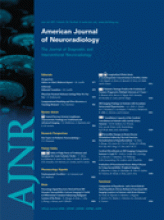We sincerely appreciate the feedback from Dr Lin and his interesting comments regarding our article entitled “Blood-Brain Barrier Permeability Assessed by Perfusion CT Predicts Symptomatic Hemorrhagic Transformation and Malignant Edema in Acute Ischemic Stroke” published in the January issue of the American Journal of Neuroradiology.1 In this article, we reported the predictive value of blood-brain barrier permeability measurements from CT perfusion scanning for complications observed in patients with acute ischemic stroke. We found that permeability measurements were 100% sensitive and 79% specific in predicting symptomatic hemorrhagic transformation and malignant edema.
As mentioned above, our primary outcome included symptomatic hemorrhagic transformation (not parenchymal hematoma type 2 [PH2]) and malignant edema, both of which were defined according to the European Cooperative Acute Stroke Study (ECASS III) criteria.2 Some of our patients, such as the one shown on the figure in the article discussed here, had a combination of hemorrhagic transformation and edema, both of which contributed to their clinical deterioration. Of note, symptomatic hemorrhagic transformation as defined by ECASS III criteria does not necessarily coincide with PH2, even if often these 2 entities overlap.
The rates of symptomatic hemorrhage in patients from the Safe Implementation of Thrombolysis in Stroke-Monitoring Study3 and ECASS III2 who received alteplase were 2.4% and 1.7%, respectively. In the pooled analysis of the National Institute of Neurological Disorders and Stroke (NINDS), Altephase Thrombolysis for Acute Noninterventional Therapy in Ischemic Stroke (ATLANTIS) and ECASS trials, the rate of PH2 was 5.9%.4 In our study, 8 patients of 32 showed a significant clinical deterioration (a National Institutes of Health Stroke Scale [NIHSS] score increase of >4 or death). Three of these 8 (9.3% of our 32 patients) had symptomatic hemorrhagic transformation (of these, 2 received intravenous tPA while 1 received intra-arterial tPA plus treatment with the Merci retriever [Concentric Medical, Mountain View, California]). Another 3 patients (or 9.3% of our 32 patients) had malignant edema (2 received intravenous tissue plasminogen activator[tPA], while 1 received intra-arterial tPA plus treatment with the Merci retriever). Finally, there were 2 patients in our study who had significant clinical deterioration due to a non-neurologic cause—aspiration pneumonia and septicemia—without symptomatic hemorrhagic transformation or malignant edema. The 6 patients with a significant clinical deterioration (an NIHSS score increase of >4 or death) and with symptomatic hemorrhagic transformation or malignant edema were included in those with positive outcomes. Our 9.2% is just above the superior limit of the confidence interval for the rate observed in the pooled analysis of the NINDS, ATLANTIS, and ECASS trials.4
Regarding the nonzero permeability values in the normal brain parenchyma, one has to remember a very important element. Our model of blood-brain barrier permeability, as all models of brain perfusion and all models in general, is not the truth, but only a simplification of the truth. Indeed, the permeability of the blood-brain barrier is a complex phenomenon that involves selective passage of certain molecules in a specific amount and nonpassage or limited passage of other molecules. The concept of modeling the blood-brain barrier permeability is meant to simplify it to a numeric value that can be used to make clinical decisions. This simplification is justified as long as 1) the model is an accurate simplification, and 2) the model is clinically relevant. From this perspective, a recent study that compares our model of blood-brain barrier to histologic findings of permeability in rats (the criterion standard) addressed issue number 1 and indicates that our model accurately depicts global changes of the blood-brain barrier permeability in the setting of brain ischemia.5 Our current study addresses issue number 2 and suggests that our model and approach are clinically relevant.
We completely agree with Dr Lin that further confirmation of our findings in a large prospective study is required before any change to the current clinical practice guidelines is considered.
- Copyright © American Society of Neuroradiology












